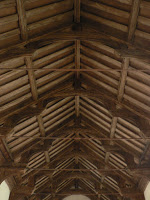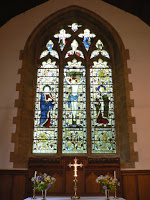St MarySt Mary
The History of St. Mary's Church
Description from 1947 Blyth Rural District "Listed Buildings" for the Church of St. Mary (Grade B, building identified by number 294 on map sheet 21):
15th century nave and square tower. 14th century chancel and south porch. Flint and stone dressing, lead roof to nave, pantiles to chancel. Fine 15th century double hammer beam roof. 15th century font. 14th century carved bench ends and poppy heads. 17th century canopied pulpit. Tablet on tower buttress records Thomas Edward was builder and Ralph Colnett assistant.
The church throughout the years




The photographs in the top row show the church in the late 1800s to early 1900s.
The second row shows the mid-1900s up to the present day.

Extracts from the church history booklet (on sale within the church), reproduced with permission:
The church which has its origins in the 13th century was originally dedicated to St. Andrew. When and why it was re-dedicated to St. Mary is not known, but one source puts the date of this as 1855.
The nave was rebuilt in the 15th century and given a superb double hammerbeam roof (fig.1, below). The carved figures, all of which, except the two, either side, at the west end have been much defaced. This is a very visible part of the damage done by William Dowsing and his men who during the Commonwealth worked through many of Suffolk's churches removing anything that smacked of 'Popery'.
The church suffered particularly severely at their hands as at the time a noted Royalist and Malignant, Sir John Cotton, son of the Lord Mayor of London, was Lord of the Manor and resident of the parish. Sir John had given large sums towards the clothing of the King's troops. All the figures in stone and wood were mutilated (fig.2, below).
During major repairs and rebuilding started in 1890 (the first major repairs for nearly 200 years), the east window was replaced with a gift by Sir Auckland Colvin in 1899 (fig.3, below). Sir Auckland also donated a new organ in 1901, and an oak lectern (fig.4, below).
Figure 1.
Double hammerbeam roof.

Figure 2.
Defaced figures on the font.

Figure 3.
East window.

Figure 4.
Oak lectern.


Until this time, the seating had been Jacobean (early 17th century) box pews, but these were replaced with individual wooden chairs. The box pews had incorporated earlier, 15th century, carved pew ends. A few of these pew ends were saved, and stored in the loft of one of the Rectory barns where they remained until rediscovered in 1928 by the newly-arrived Rector, Rev. Thos. Brown as he was being shown round by the churchwarden, George Whymark. Their enthusiasm for their find was such that, working from these originals, additional pew ends were created by Archdeacon Darling's group of woodcarvers based at Eyke. The seats and backs of the benches were mostly made in Earl Soham in the workshops of Wm. Baldry. The spirit of the original pew ends is so well caught that in some cases it is difficult to tell the old from the new. The salvaged medieval ends can in fact be found in the first five rows.
These pews were installed during the 1930s.
Electricity was first installed in the church in 1927. The candelabra now hanging throughout the church are the work of Hector Moore, a blacksmith in the neighbouring village of Brandeston, and internationally renowned.
The tower has a peal of six bells, the oldest of which, like the tower itself, date from about 1470. The bells were rehung in 1898 and again in 1976, and are still in regular use.
The Bells of St Marys
| Their Inscriptions and Weights. Treble We who are now six Bells were for a long time only five, I came last and celebrate again with pleasant tongue, here whilst I hang, the happy Day. Aucland Colvin 1901. 5 cwt I qr 4 lbs 2nd 1663 John Darbie made me R.D.H.E.W.F. 4 cwt 3 qrs 20 lbs 3rd Quaesumus Andrea Famulorum Suscipe Vota (We pray thee, Andrew, receive the vows of thy servants) 5 cwt I qr 4th 1610 Miles Grays made me. 5 cwt 3 qrs 11 lbs 5th Petrus Ad Eterne Ducat Nos Pascua Vite (May Peter lead us to the pastures of eternal life) 8 cwt 3 qrs Tenor 1663 John Darbie made me. 11 cwt 16 lbs FROM OUR PARISH RECORDS As Lords of the Manor, successive Dukes of Norfolk built up our beautiful church over the remains of a still older one. The side windows of the chancel date from about 1320, and the main part of the tower itself from 1350. When buttresses were added about 1510 one of the stone inscriptions tell us that the tower had been built by Thomas Edouard, who was presumably the second duke. The third Duke, John de Mowbray, is said to have built Earl Soham Lodge. The fourth duke is held to have rebuilt Framlingham church and it was presumably he who gave the order for the founding of the 3rd and 5th of our present peal of bells, at the same time as the nave was built. These two were cast at Robert Brazyer's Norwich foundry between 1460 and 1470. He may have given two more, for in 1553 the Commissioners left at "Some Comitis in Lowes Hundred: Great Bells iiii". The prayer to St Andrew on the 3rd, and the shield with the cross of St Andrew above the small west window on the outside of the tower, remind us that until 1840 the dedication of the church was always ascribed to St Andrew. In view of the fact that we have been repeatedly warned that we must rehang the bells at a cost of some £1,000, the following items from the accounts of churchwardens in the reign of Good Queen Bess may be of interest. (Note that the spelling is as in the records - it may help to say the words with a broad Suffolk accent! The letters in italics are pre-decimal currency of £. s. d. - i.e. pounds, shillings and pence. The moving of the bells in 1584 was obviously thirsty work, calling for considerable expenditure on beer!) 1575 Item layd out to John Manlyng for a new bellrope xv d to A Mepom for mendyng of the clocks ii s iiii d to Kaye for stoken of ye belles ii d to my father lawe Dwe for xxxviii lb belle meatell xii s iiii d to George Fellepes for xlii lb of belle meatell 5 s for half a hundred of belle meatell at Woodebrege xviii s at Epsweche for 4X & iii lbs xxi s To Wade of Esten for helpyng of the bell man ii s Payde to hayward for helpyn of John bell man v s viii d To John palle for hys work £ iii William Harman chyrchwarden in anno 1576 Item layd oute to John ye Smythe for ye bellys i d John ye smythe for spyles for ye bellys ii d to ye ringers on ye coronacion day xvi d 1577 Payd to Thomas haywarde wytt for the ringers on the crownenacyion days xii d Accounts of Nicolas Deve churchwarden 1584 Payd for Spyles for the belles i d Payd for mending the great bell knepele xx d Payd for irons and nayles & ii Stapels vi d Payd for mending the lesser bell Knepell vi d Payd for nayles and moost the spiles ii d Payd at Frammingame for bere at the feching home of the belles iii d Payd the same day agayne when they came home for bere ii d Payd to Wolfe's wife agayne for bere at the taking downe and waying of the same bells ix d Payd to arter Cursp of Frammingam for hanging of the belles vi s vii d 1591 Payd for the bell kneapell xiii s viii d 1593 (Thomas Folkes one of the church wardens of the towne of Earl Soham) Payd for grease for the belles i d (the account of Herry Thrower one of the churchwardens...) for a bele rope ii s vi d to blowers for a lute strynge for the clocke viii d It. payed to John haywards the xxxi days of march for a pese for the beall rope xi d for mender the baldrecke for the bealles iii d to harmies for a Key and Seting on a locke of the stepell dore xii d for half a calf skene to mend the bealles ropes v d to the commissore for oure belles indented iiii d for maker of the deyell for the clocke xiii s iiii d for a rope for ye clocke iiii d During this period there were other items such as 'xviii s payd for vi bushils of wheate for the quene.", three firkings of butter to Woodbridge for the victualling of "her Majatis navy", butter, claves or kine for her use, the equipping of a soldier for her wars, the provision of swords, dagards, collivers, bows and arrows. Also help for "the maymed solgers", "for trayning of the solgers", and help in kind to poor people and children. A stranger had to be "carted out of the parish", or a man or a "woman to jayle" The glazing of the church had to be repaired repeatedly, and sometimes its "Leade". Miles Graye of Colchester, who flourished between 1600 and 1630, made Bell no 4. His most famous bell is the Lavenham Tenor, which ringers say may be the finest in the kingdom. Ours was made the same year as the bell in St Mary le Tower, Ipswich. Bells Nos. 2 and 5 were made by John Darbie, an Ipswich founder who flourished round the time of the Great Fire of London, 1660. They were rehung in 1898 and a sixth given by Sir Aucland Colvin of the ICS who also gave the East window in memory of his father who was governor of Bengal. Sir Aucland's face and that of Canon Abbay are featured as gargoyles outside the window. The first peal of the six bells was a Doubles of 5040 changes rung with deeply muffled bells on the day of the funeral of Queen Victoria. A Minor of the same number was rung similarly for the funeral of Edward VII. Altogether the feat was accomplished twelve times by 1912, the leader on most occasions being Mr. WG Crickmer who rang for over 50 years. |
